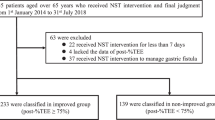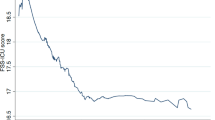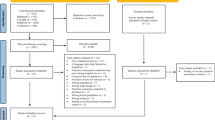Abstract
Background/Objectives
Septic Surgery Center (SSC) patients are at a particularly high risk of protein-energy malnutrition (PEM), with a prevalence of 35–85% found in various studies. Previous collaboration between our hospital’s SSC and its Clinical Nutrition Team (CNT) only focussed on patients with severe PEM. This study aimed to determine whether it was possible to improve the quality of nutritional care in septic surgery patients with help of a nutritional policy using the Nutritional Risk Score (NRS).
Subjects/Methods
Nutritional practices in the SSC were observed over three separate periods: in the 3 months leading up to the implementation baseline, 6 months after implementation of preventive nutritional practices, and at 3 years. The nutritional care quality indicator was the percentage of patients whose nutritional care, as prescribed by the SSC, was adapted to their specific requirements. We determined the septic surgery team’s NRS completion rate and calculated the nutritional policy’s impact on SSC length of stay. Data before (T0) and after (T1 + T2) implementation of the nutritional policy were compared.
Results
Ninety-eight patients were included. The nutritional care-quality indicator improved from 26 to 81% between T0 and T2. During the T1 and T2 audits, septic surgery nurses calculated NRS for 100% and 97% of patients, respectively. Excluding patients with severe PEM, SSC length of stay was significantly reduced by 23 days (p = 0.005).
Conclusions
These findings showed that implementing a nutritional policy in an SSC is possible with the help of an algorithm including an easy-to-use tool like the NRS.
This is a preview of subscription content, access via your institution
Access options
Subscribe to this journal
Receive 12 print issues and online access
$259.00 per year
only $21.58 per issue
Buy this article
- Purchase on Springer Link
- Instant access to full article PDF
Prices may be subject to local taxes which are calculated during checkout



Similar content being viewed by others
References
Lamb CA, Parr J, Lamb EI, Warren MD. Adult malnutrition screening, prevalence and management in a United Kingdom hospital: cross-sectional study. Br J Nutr. 2009;102:571–5.
Beck AM, Balknas UN, Furst P, Hasunen K, Jones L, Keller U, et al. Food and nutritional care in hospitals: how to prevent undernutrition--report and guidelines from the Council of Europe. Clin Nutr. 2001;20:455–60.
Kyle UG, Pirlich M, Schuetz T, Luebke HJ, Lochs H, Pichard C. Prevalence of malnutrition in 1760 patients at hospital admission: a controlled population study of body composition. Clin Nutr. 2003;22:473–81.
Bruun LI, Bosaeus I, Bergstad I, Nygaard K. Prevalence of malnutrition in surgical patients: evaluation of nutritional support and documentation. Clin Nutr. 1999;18:141–7.
Eneroth M, Olsson UB, Thorngren KG. Insufficient fluid and energy intake in hospitalised patients with hip fracture. A prospective randomised study of 80 patients. Clin Nutr. 2005;24:297–303.
Senet P, Meaume S, Gouronnec A, Lecoz D, Debure C. Evaluation du statut nutritionnel des malades atteints d’ulcères de jambe. Ann Dermatol Venereol. 2002;129:381–5.
Burgos R, Sarto B, Elio I, Planas M, Forga M, Canton A, et al. Prevalence of malnutrition and its etiological factors in hospitals. Nutr Hosp. 2012;27:469–76.
Hengstermann S, Fischer A, Steinhagen-Thiessen E, Schulz RJ. Nutrition status and pressure ulcer: what we need for nutrition screening. JPEN J Parenter Enter Nutr. 2007;31:288–94.
Pedersen NW, Pedersen D. Nutrition as a prognostic indicator in amputations. A prospective study of 47 cases. Acta Orthop Scand. 1992;63:675–8.
Eneroth M, Apelqvist J, Larsson J, Persson BM. Improved wound healing in transtibial amputees receiving supplementary nutrition. Int Orthop. 1997;21:104–8.
Chevalier P, Delpeuch F, Maire B. Le complexe “malnutrition-infection”: premier problème de santé publique chez les populations défavorisées. Med Mal Infect. 1996;26:366–70.
Lesourd B, Ferry M. Le sujet âgé. In: Leverve X, Cosnes J, Erny P, Hasselmann M, editors. Traité de nutrition artificielle de l’adulte, 2nd ed. Paris: Springer; 2001. p. 661–77.
Dickhaut SC, DeLee JC, Page CP. Nutritional status: importance in predicting wound-healing after amputation. J Bone Jt Surg Am. 1984;66:71–5.
Eneroth M, Larsson J, Oscarsson C, Apelqvist J. Nutritional supplementation for diabetic foot ulcers: the first RCT. J Wound Care. 2004;13:230–4.
Iizaka S, Okuwa M, Sugama J, Sanada H. The impact of malnutrition and nutrition-related factors on the development and severity of pressure ulcers in older patients receiving home care. Clin Nutr. 2010;29:47–53.
Lindholm C, Sterner E, Romanelli M, Pina E, Torra y Bou J, Hietanen H, et al. Hip fracture and pressure ulcers - the Pan-European Pressure Ulcer Study - intrinsic and extrinsic risk factors. Int Wound J. 2008;5:315–28.
McClave SA, Finney LS. Nutritional issues in the patient with diabetes and foot ulcers. In: Bowker JH, Pfeifer MA, editors. Levin and O’Neal’s The diabetic foot, 6th ed. St. Louis: Mosby; 2001. p. 212–8.
Fontaine J, Raynaud-Simon A. [Pressure sores in geriatric medicine: the role of nutrition]. Presse Med. 2008;37:1150–7.
Dubertret L, Raynaud-Simon A, Senet P. Cicatrisation. In: Leverve X, Cosnes J, Erny P, Hasselmann M, editors. Traité de nutrition artificielle de l’adulte, 2nd ed. Paris: Springer; 2001. p. 377–84.
Burrowes JD, Dalton S, Backstrand J, Levin NW. Patients receiving maintenance hemodialysis with low vs high levels of nutritional risk have decreased morbidity. J Am Diet Assoc. 2005;105:563–72.
Dwyer JT, Larive B, Leung J, Rocco MV, Greene T, Burrowes J, et al. Are nutritional status indicators associated with mortality in the Hemodialysis (HEMO) Study? Kidney Int. 2005;68:1766–76.
Correia MI, Waitzberg DL. The impact of malnutrition on morbidity, mortality, length of hospital stay and costs evaluated through a multivariate model analysis. Clin Nutr. 2003;22:235–9.
Brem H, Lyder C. Protocol for the successful treatment of pressure ulcers. Am J Surg. 2004;188(1A Suppl):9–17.
Brem H, Sheehan P, Rosenberg HJ, Schneider JS, Boulton AJ. Evidence-based protocol for diabetic foot ulcers. Plast Reconstr Surg. 2006;117(7 Suppl):193S–209S. discussion 210S-11S
Kondrup J, Allison SP, Elia M, Vellas B, Plauth M, Educational. et al. ESPEN guidelines for nutrition screening 2002. Clin Nutr. 2003;22:415–21.
Kondrup J, Rasmussen HH, Hamberg O, Stanga Z. Nutritional risk screening (NRS 2002): a new method based on an analysis of controlled clinical trials. Clin Nutr. 2003;22:321–36.
Dickinson A, Shao A, Boyon N, Franco JC. Use of dietary supplements by cardiologists, dermatologists and orthopedists: report of a survey. Nutr J. 2011;10:20.
Colditz GA, Willett WC, Rotnitzky A, Manson JE. Weight gain as a risk factor for clinical diabetes mellitus in women. Ann Intern Med. 1995;122:481–6.
Gregg EW, Cheng YJ, Narayan KM, Thompson TJ, Williamson DF. The relative contributions of different levels of overweight and obesity to the increased prevalence of diabetes in the United States: 1976-2004. Prev Med. 2007;45:348–52.
Charlson ME, Pompei P, Ales KL, MacKenzie CR. A new method of classifying prognostic comorbidity in longitudinal studies: development and validation. J Chronic Dis. 1987;40:373–83.
Osterkamp LK. Current perspective on assessment of human body proportions of relevance to amputees. J Am Diet Assoc. 1995;95:215–8.
Di Iorio BR, Scalfi L, Terracciano V, Bellizzi V. A systematic evaluation of bioelectrical impedance measurement after hemodialysis session. Kidney Int. 2004;65:2435–40.
Frisancho AR. New norms of upper limb fat and muscle areas for assessment of nutritional status. Am J Clin Nutr. 1981;34:2540–5.
Kyle UG, Genton L, Slosman DO, Pichard C. Fat-free and fat mass percentiles in 5225 healthy subjects aged 15 to 98 years. Nutrition. 2001;17:534–41.
Sinuff T, Cahill NE, Dhaliwal R, Wang M, Day AG, Heyland DK. The value of audit and feedback reports in improving nutrition therapy in the intensive care unit: a multicenter observational study. JPEN J Parenter Enter Nutr. 2010;34:660–8.
Kyle UG, Pirlich M, Lochs H, Schuetz T, Pichard C. Increased length of hospital stay in underweight and overweight patients at hospital admission: a controlled population study. Clin Nutr. 2005;24:133–42.
Beghetto MG, Koglin G, de Mello ED. Influence of the assessment method on the prevalence of hospital malnutrition: a comparison between two periods. Nutr Hosp. 2010;25:774–80.
Stratton RJ, Hackston A, Longmore D, Dixon R, Price S, Stroud M, et al. Malnutrition in hospital outpatients and inpatients: prevalence, concurrent validity and ease of use of the ‘malnutrition universal screening tool’ (‘MUST’) for adults. Br J Nutr. 2004;92:799–808.
Schindler K, Pernicka E, Laviano A, Howard P, Schutz T, Bauer P, et al. How nutritional risk is assessed and managed in European hospitals: a survey of 21,007 patients findings from the 2007-2008 cross-sectional nutritionDay survey. Clin Nutr. 2010;29:552–9.
Acknowledgements
We thank the patients who participated in this study for their kind cooperation. We are indebted to the nurses and dietitians of the Unit of Clinical Nutrition for their support during data collection. We thank the nursing staff from the Septic Surgery and Acute Dialysis Centers for their collaboration during data collection, especially Michel Blanchet, José Da Silva Raposo, Valérie Kern, and Anne Van Ranst. We also thank Alice Panchaud and Christine Hug for their precious help, Daniel Teta for his kind cooperation, Michel Cheseaux for his participation in the baseline audit, and Michel Roulet for supervising the study.
Author information
Authors and Affiliations
Corresponding author
Ethics declarations
Conflict of interest
The authors declare that they have no conflict of interest.
Rights and permissions
About this article
Cite this article
Grolimund Berset, D., Guex, E., Valentinuzzi, N. et al. Improving nutritional care quality in the orthopedic ward of a Septic Surgery Center by implementing a preventive nutritional policy using the Nutritional Risk Score: a pilot study. Eur J Clin Nutr 73, 276–283 (2019). https://doi.org/10.1038/s41430-018-0345-1
Received:
Revised:
Accepted:
Published:
Issue Date:
DOI: https://doi.org/10.1038/s41430-018-0345-1



